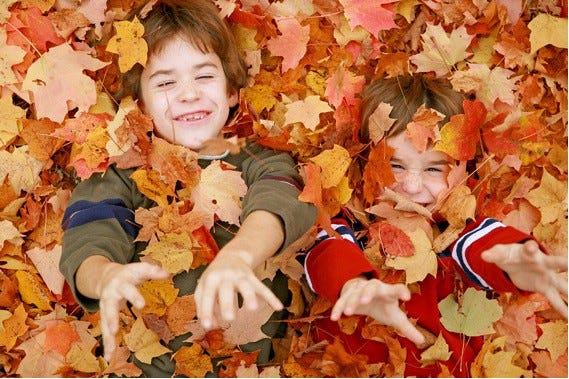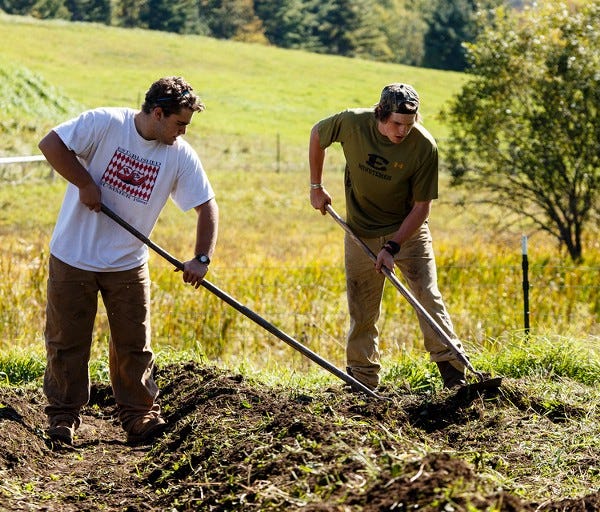Why kids need to get their hands dirty
I was a bit jealous when I heard about Joshua’s latest homework assignment: Go outside and jump in a pile of leaves. It was November, and…

I was a bit jealous when I heard about Joshua’s latest homework assignment: Go outside and jump in a pile of leaves. It was November, and crisp autumn leaves covered the ground at my nephew’s home in Needham, MA.
Was this really what 6th grade was like these days? What happened to the misery-inducing spelling tests and math problem sets I remember?
I thought about this leaf-jumping exercise after reading an article by Ben Fogle, who suggests that kids can benefit by spending more time in nature and less time in classrooms preparing for standardized tests.

Fogle writes, “Free play in the outdoors is good for social and emotional development, improves self-awareness, and makes children more co-operative.”
As an uncle to 3 little boys, I’ve seen how important it is for kids to get away from video game & iPods and get outdoors. This may sound obvious to some parents, but it’s an increasing challenge in today’s technology-filled, test-based educational system.
According to a study by the American Medical Association, children are happier, healthier and get along with others better when they have regular opportunities for free and unstructured play outside. There’s scientific evidence that the wilderness can reduce hyperactivity and has a soothing effect on children, especially those suffering from ADD.
Studies like these underscore how our traditional model of K-12 education is failing our nation’s kids. The obsessive focus on testing creates huge amounts of stress. It makes students lose faith in their ability. Skills like creativity and teamwork are ignored; students are rewarded for regurgitating facts from a textbook.
Sure, classroom-based lesson plans and standardized tests serve important roles. Kids need to learn basic skills like reading, writing, and math. Testing is a useful yardstick to measure a student’s progress and identify areas that need improvement.
But it’s becoming clear that children learn better through self-directed exploration and following their own native curiosity — what teachers refer to as “experiential education.”
Understanding our connection to the natural world is a crucial part of learning — and one that’s hard to get when you’re stuck inside a classroom.

One of my greatest educational experiences was summer camp at Farm & Wilderness in upstate Vermont. Living on a working farm was a huge culture shock at first. But I adapted to my new environment. I learned to milk cows and harvest fruits & vegetables. We practiced knife skills and how to build fires. My bunk and I slept every night in a log cabin with no electricity.
Every morning we’d sit together in a circle for a traditional Quaker meeting, the silence interrupted only by an occasional word of gratitude or self-reflection. I didn’t realize it at the time, but I was learning a form of meditation. This kind of solitary quiet is something I’ve come to value immensely. In today’s hyper-connected world, it’s rare to find a kid who can sit still without the constant stimulation of an electronic device.

I’ve heard similar stories from my friends who attended The Mountain School. It’s an innovative program for high school students that combines classroom-based teaching with experiential education related to science, the natural world and the environment.
I’ve also contributed to Project Morry, a nonprofit that places underprivileged inner-city kids in summer camps across the country. The experience has made a real impact on students’ lives. They’re more likely to graduate high school and go on to successful careers.

Education should be about preparing children for life beyond the classroom. Nature is one giant laboratory for learning and experimentation — observing plants & trees, measuring rainfall and soil conditions, using microscopes to examine tree moss, seeing how animals interact in the wild.
These lessons have never been more important in a world where climate change threatens our very survival. Being immersed in nature helps children understand how we’re all connected, and why it’s important to preserve a diversity of species and ecosystems.
Before Theodore Roosevelt became president, he spent his childhood exploring nature and wildlife. At age 9 he wrote his first essay on insect species and ornithology; years later he fought to make Yellowstone a federally protected national park.

His 1908 speech on conservation resonates today:
“The time has come to inquire seriously what will happen when our forests are gone, when the coal, the iron, the oil and the gas are exhausted, when the soils have been still further impoverished and washed into the streams, polluting the rivers, denuding the fields, and obstructing navigation. These questions do not relate only to the next century or to the next generation. It is time for us now as a nation to exercise the same reasonable foresight in dealing with our great natural resources that would be shown by any prudent man in conserving and widely using the property which contains the assurance of well-being for himself and his children.”
There will always be a role for lectures, books and exams in school. But there’s a limit to what can be learned inside a classroom. We should do our children a favor and give them freedom to enjoy the vast educational resources that lie just outside our door.


